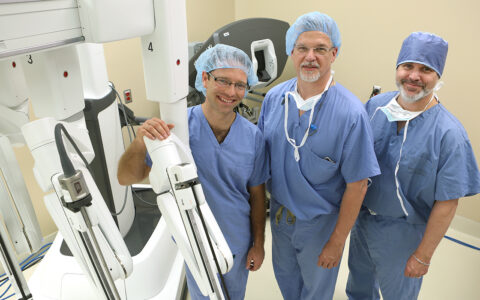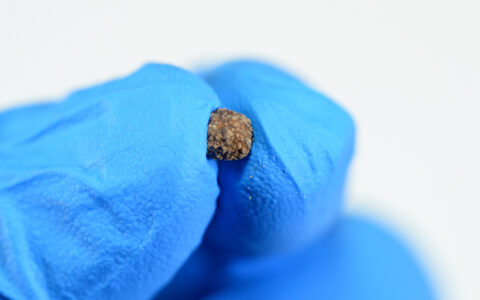Urologist Kristen R. Scarpato, M.D., M.P.H., has led Vanderbilt University Medical Center in adoption of high-intensity focused ultrasound (HIFU) as an alternative therapy for patients with intermediate risk (Gleason 3+4, Gleason 4+3) prostate cancer.
While the treatment is still relatively new, short-term data suggest this approach could minimize side effects for these patients while effectively treating prostate cancer.
Scarpato is vice chair of education and residency program director in the Department of Urology. Here, she shares insights about why HIFU has become an increasingly popular choice for eligible patients.
Discoveries in Medicine: What makes HIFU a good treatment option today and for which patients?
Scarpato: Patients who may benefit from primary focal therapy include those who are newly diagnosed, with small to average size prostate glands and less-aggressive unilateral tumors, where partial gland ablation has a high chance of cure. This would be in lieu of active surveillance, radical prostatectomy, or radiation therapy.
Salvage therapy with HIFU following primary radiation therapy is another place we see benefits. A rising PSA or ‘biochemical recurrence’ after treatment may indicate recurrent cancer. If the biopsy shows recurrent cancer, and imaging is negative for cancer spread, patients have several salvage-therapy options: continue to monitor; perform a salvage radical prostatectomy; repeat radiation; or ablate prostate tissue through cryotherapy or HIFU.
Of these salvage options, monitoring alone may not be a comfortable option for some patients. Yet, radical prostatectomy following radiation comes with a high risk of post-operative urinary and sexual side effects. In many cases, ablation with cryotherapy or HIFU treatment to destroy the cancer cells may strike the best balance between oncologic control, safety and quality of life.
For some, ablation may be “kicking the can down the road,” and that is not necessarily a bad thing, especially if that means avoiding side effects or hormonal therapy. In the primary setting, recurrence rates are in the 15-to-45 percent range over a 5-to-10-year time frame. About half of patients will have long-term success with HIFU as a salvage therapy and be spared prostatectomy or hormonal systemic therapy that can negatively impact their quality of life.
Another positive feature of HIFU is that it doesn’t limit future treatment options if there is cancer recurrence.
Discoveries: How does HIFU work?
Scarpato: Under ultrasound guidance, high intensity ultrasound waves are focused on the area where cancerous tissue has been identified on prior biopsy and imaging. There is a rapid temperature increase in the tissue, destroying cells in the targeted zone. By precisely moving the focal point of each wave, it is possible to destroy part of the prostate gland without damaging the surrounding tissues.
“We are getting better and better at accurately imaging important cancers, and this allows us to use HIFU – as well as or cryotherapy – to more effectively and selectively target cancer cells.”
We are getting better and better at accurately imaging important cancer, and this allows us to use HIFU – as well as or in addition to cryotherapy – to more effectively and selectively target cancer cells.
Discoveries: What forms of ultrasound ablation are available, and what do you use?
Scarpato: There are many new and emerging forms of ablation – it’s an area that is exciting and rapidly evolving.
A transurethral ultrasound ablation (TULSA) approach is often utilized and has become more common since a 2023 study that showed favorable incontinence and sexual side effects. With our initial experience using whole gland therapy, some found the procedure labor-intensive because is requires real-time MRI guided technology and a suprapubic tube patients do not like.
At this point, I prefer the transrectal HIFU procedures with its low-side-effect profile and less procedural burden. TULSA may be a good ablative option for a patient with advanced prostate cancer who doesn’t have a rectum due to prior colorectal surgery.
Data on the CAPTAIN Trial, which compares TULSA to radical prostatectomy in patients with intermediate risk prostate cancer, is forthcoming.
Discoveries: In what patients is HIFU contraindicated?
Scarpato: For patients with large glands, significant coarse prostate calcifications, or rectal disease, HIFU is not a good option. Additionally, I am concerned that in patients with recurrence after brachytherapy, the radioactive seeds will block the ultrasonic waves or reflect heat back to rectal tissue already compromised by radiation, risking fistula development. In these cases, cryotherapy might be a better option, as long as the patient doesn’t have a low pubic arch.
These decisions can become complex. The good news is that with both salvage HIFU and cryotherapy,about 50 percent of patients will have success and be spared the need for hormonal therapy or systemic therapy that will really negatively impact their quality of life.
Discoveries: How many patients do you treat with HIFU or cryotherapy?
Scarpato: Currently, we see about 20 patients a year for primary focal therapy, and this number is growing. Our salvage therapy volume using both cryotherapy and HIFU is also increasing, as technology and our understanding of which patients are best candidates continue to improve.
Discoveries: Do you see anything on the research horizon that may influence future HIFU use, and what are you currently doing to drive improvements?
Scarpato: There is absolutely a lot happening in this space, with new data emerging regularly and novel techniques being explored. Along with clinical efficacy and quality-of-life outcomes, much of the data is also on decisional regret and financial toxicity. With prostate cancer, treatment decision-making is very much shared, and quite nuanced. No one size fits all.
Our field is continually exploring new technologies that might compete with what we do now and ultimately offer viable alternatives for our patients. Some of our current goals are to find ways to better stratify patients with improved imaging and use of biomarkers.
Patients today are savvy – they are asking good questions! – and all of this, I think, is driving us to be better with our ablation. People understand now that we don’t always have to treat the whole gland, with the significant reduction in quality of life and side effects that may follow.




